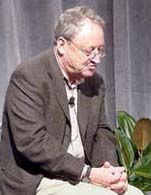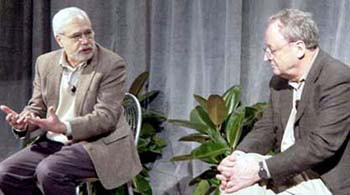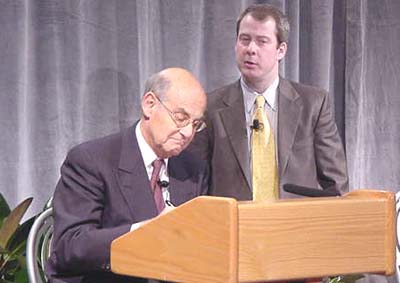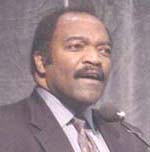|
E-Topia
/ Designing Cambridge: |
||||||
|
linked forums: How Well Does Media Serve Cambridge Citizens? and How Can Information Technologies Serve Cambridge? Abstract For over a decade, the convergence of the computer and telecommunications industries has inspired grand predictions of a bright new world of freedom and prosperity . . . an "e-topia." And we have seen advanced communications technologies help to improve business practices, enhance medical services, enrich educational opportunities and deliver a wide array of entertainments to our homes. But how can these advanced telecommunications services be used to foster strong local democratic communities? How are these communications technologies being used, if at all, in the City of Cambridge? And what role, if any, does local government play in making sure 21st-century communications technologies serve public needs? William
Mitchell, is the academic head of the MIT Media Lab
and author of several books on how advanced communications technologies
can be used to benefit communities, including e-topia: "Urban
Life, Jim — But Not As We Know It." Mitchell will
discuss the civic use of communications technologies. John Barrett is the director of research at the Beacon Hill Institute at Suffolk University. He manages the Institute's State Tax Analysis Modeling Program (STAMP) and conducts research for other projects at the Beacon Hill Institute. James N. Horwood is an attorney with Spiegel & McDiarmid, a Washington D.C. law firm that represents local and state governments and consumers on infrastructure issues, particularly those involving energy, telecommunications, the environment, and transportation.
WILLIAM MITCHELL believes that understanding the relationship between new communications technology and the use of architectural space is key to developing cities in the 21st century. To begin, he recalled the early days of computers, when they were large, rare, and expensive beasts. People who wanted to do computational work had to go to a computer center. This was like the experience of going to a village well for water; the computer offered a scarce and precious resource. It occupied special sites available to a privileged few. Decades later in the1990s, a democratization of computing occurred with the development of the internet, networking, and the low cost personal computer. Mitchell showed a slide of an outdoor café table with a wired computer for public use in Adelaide, Australia. The slide illustrated how in this era, you had access to computer and communications technology at wherever the infrastructure extended, but the extent of access was still limited. Nowadays, with the proliferation of portable devices and wireless technology, access to communications is virtually everywhere. People can informally appropriate space for computing, superimposing new functions onto locations by means of wireless access. This results in interesting social effects. Around the MIT campus, informal locations like cafes, outdoor areas, and the nooks and crannies of corridors are being used for getting work done. Something that has changed the dynamics in classrooms is the student's ability to look up information related to the lecture on the internet. It creates an intensity and speed in the discussion that is exhilarating and qualitatively different. These examples demonstrate the strong relationships between the way technology works, particular physical settings, and the kinds of social situations that arise. Public urban areas can also be transformed by this flexible, ad-hoc use of space. Free wireless access available in Manhattan's Bryant Park has changed the use of the park, drawing people out of surrounding office buildings to do work in good weather. It also increased the value of the surrounding real estate by adding to the amenity to the public space. The most commercially established wireless networking technology is 802.11. Fundamentally, it is inexpensive, incremental, and can be deployed in grassroots kinds of ways. A large-scale infrastructure program is not needed to transform the public spaces of a city. Wireless technology allows for experimentation and small-scale projects that have potentially great impacts. To conclude, Mitchell showed a map of Newbury Street in Boston, which is now blanketed with wireless hotspots that have given the commercial district new patterns of activity. Discussion DAVID THORBURN, director, MIT Communications Forum: A problem that has struck many of us is how to respond to the terrific rate of change of technologies. A city could commit to a certain kind of technology that is quickly supplanted by something new. How do we deal with the instability of technological platforms? MITCHELL: That is a very profound problem. First of all, that is why experimental and incremental approaches that do not involve high-risk bets on the technologies are the best strategies. Secondly, the social goals that are achieved are robust and worthwhile, even if the technological decisions are not perfect. QUESTION: Why do you think Cambridge does not have more wireless access now, especially with the presence of schools like MIT and Harvard? MITCHELL: Universities are not necessarily well positioned to be infrastructure developers for cities. They are better at things like providing useful resources, such as MIT's OpenCourseWare program. QUESTION: The deployment of wireless technologies has made individual access easier. What architectural influences could encourage more group interaction? MITCHELL: Years ago when MIT started to wire up dorm rooms, one of the consequences was that many students never left their rooms. The social effect was fragmentation and a diminished use of public space. Now, since we have provided access in lounges and cafés, it has taken group interactions out to public spaces. If you think of public space as the manifestation of community, this is an important result. QUESTION: What specific environments in Cambridge would make good locations for free wireless access? MITCHELL: Besides libraries and community centers, I would love to see the main urban spaces such as Massachusetts Avenue, the banks of the Charles River, and the major squares blanketed with wireless access. It would intensify the life in these locations. In good weather, outdoor spaces will have a new overlay of activity. QUESTION: If wireless is the future of public space, what is the future of public art? MITCHELL: It is interesting to think about how you can overlay narrative onto public space, or how you can make the stories of certain places come alive. Cambridge, with its rich history and diverse population, has many stories to tell, related to particular locations in the city. One extraordinary thing I would like to see done on a large scale would be to make these narratives come alive on portable devices as you move around the city. QUESTION: What about the public good involved in creating communication infrastructure projects, which are so few in the United States? How would one articulate the argument to justify the expense involved in these projects?
MITCHELL: One part of the answer is that the expense is not necessarily great. I have already mentioned that small-scale projects can have great effects. I'll give you three more arguments. First of all, public space is fundamentally important to any city. They have to make the space work, not just create the space on the map. They must have attractions that will draw people into them. Many traditional things no longer work, much like the concept of the village well. However, one thing that does attract these days is the ability to do multiple tasks in a public space. Secondly, a city like Cambridge depends on its competitiveness for attracting talented and highly mobile people. Cambridge has many attractions now, but so do many other places. Providing new levels of civic amenities that attract and retain talent is an important economic strategy. Finally, improving public spaces is a way of creating social equity.
In March 2003, the Cambridge City Counsel put a question to the city manager's office about whether the city should establish its own cable system. John Barrett and James N. Horwood gave their views on this question. JOHN BARRETT became interested in the municipal overbuilds of cable systems when the town of Norwood, Massachusetts, who was interested in entering the broadband market, asked the Beacon Hill Institute to research similar projects around the country. He has seen three major reasons that municipalities give to justify entrance into the broadband market. First is to spur economic growth, which is an unreasonable goal for very small towns. Next, cities complain about the lack of competition in the private sector. Finally, there is the claim that their goal is not profit, but to lower internet and telephone rates for citizens. Barrett believes that when the aim is not profit at some level, inefficient decisions are inevitably made. Services that are traditionally provided by the public sector - such as electricity, water, or police services - have relatively low stable capital requirement. These services either rely on human capital, or on infrastructure that needs little reinvestment over the years. They are public monopolies, with which the public has little choice. If more capital is needed, the city can get funding from revenue bonds. The characteristics of the broadband market are completely opposite. It is highly capital-intensive, and the technology is fluid and changing. Fierce competition exists not only with other cable providers, but with satellite TV operators as well. Because bond issuers deem the business as too risky, projects will not be funded by revenue bonds. Instead, general obligation bonds are issued, which may have to be paid back from taxes. If there is a lack of competition in the market, the town should ask why only one provider exists. Shrewsbury, Massachusetts was successful with its municipal cable operation largely because no one else was providing service from the start. A private company near the area would not compete against the town, because Shrewsbury was too small to support two companies, and would not be worth the capital investment. Finally, a town must ask itself, what are the possible outcomes if they enter the market? Typically, there are two results. If a municipality enters the market against an existing competitor, they may end up splitting the customer pool 50-50, and then both will suffer losses. A large company like Comcast can stand the loss and make their profits in other markets, but the city does not have that luxury. In the other scenario, the city succeeds and the incumbent is forced out. However, the public provider is now responsible for keeping up with the technology, and must constantly issue new bonds to fund it. If the technology does not work out, the tax rates go up.
JAMES N. HORWOOD provided a different perspective. Federal legislation was intended to create competition in the telecommunications market, but failed because of the dominant companies' strong-arm tactics. Horwood believes the only way to bring competition and discipline the market is if municipalities enter with a different motivation, which is not necessarily profit, but answering to citizens and providing benefits to society. Competition from municipalities is in the public interest. . Horwood also believes that the concern of increased taxes is overblown. As long as a feasibility study is done, and a reasonable business plan is drawn, a city will at least recover costs. Norwood, Massachusetts chose to move forward after their feasibility analysis. After being in operation for a year, they are currently ahead of schedule in rolling out their services. Cambridge must keep in mind however, that almost all the municipalities with telecommunications systems were experienced with providing other utilities. Cambridge does not have a municipal electric system, so constructing a business plan would be more difficult. BARRETT responded with some additional points about the Norwood study. When the town was deciding whether or not to enter the broadband market, the incumbent provider was AT&T, who had plenty of problems at the time. They were not upgrading their systems, and were waiting for others to buy them out. Comcast has since taken over and upgraded the area. Norwood has been in business for a year, and they have around 2,300 customers. Their business plan needs 61% of the market to succeed, which may have been reasonable against AT&T, but not Comcast. A subtler problem for municipal providers is programming costs, which are a large part of cable costs. For every channel they wish to carry, they must deal with each individual programmer and pay a per-subscriber rate. Companies such as Comcast have subscribers nationwide, and pay a lower rate because advertisers will be reaching a greater audience. Comcast itself owns channels as well. If a town like Norwood approaches Comcast to buy programming, they cannot expect to get a favorable deal from their competitor. However, HORWOOD pointed out that a national cooperative of municipal cable systems and smaller private providers exists, who negotiate with programmers in bulk. Ultimately, both speakers emphasized the importance of doing a thorough feasibility analysis. While Barrett remains skeptical that a company not motivated by profit could be efficient, Horwood believes the city should eventually move forward as long as they think they have a winning proposition, and are prepared to fight with incumbent forces.
MARK LLOYD, MIT Martin Luther King Jr. Visiting Scholar: Bill Mitchell just spent a lot of time discussing wireless technology. Would it make sense for Cambridge to leapfrog over the problem of investing in cable infrastructure, and spur wireless technology instead? BARRETT: It depends on the goal. The earlier issue was transforming public spaces. Cable is different, because it provides a service to every individual home that wants it. HORWOOD: Wireless is not a substitute for everything cable provides, such as video. Also, I do not think it has the level of security that a wired technology does. LLOYD: Why do you think the increased interest by municipalities to enter the telecommunications market is such a hot issue today? HORWOOD: People are very dissatisfied with the prices and level of service they are getting with big companies. And there is the motivation for smaller cities to attract and retain talented residents and businesses. There are cases such as Cedar Falls, Iowa, who went into the municipal telecommunications business and thrived with new jobs, leaping ahead of neighboring cities. BARRETT: I think it depends on the city. Remember that many municipalities with cable operations were successful at providing electric service, which makes the business slightly easier. QUESTION: Although Cambridge no longer provides electrical services, it still provides water. Are there any other specific factors about Cambridge that might point to either success or failure at running its own cable operation? BARRETT: I think there are points for both sides. Unlike more rural towns, Cambridge is relatively dense, so it would be able to access more homes in a small area. On the downside, the city would be competing with a couple of other operators. Furthermore, I think Cambridge residents lack the overall loyalty to the city. A large percentage of the population is either students or transient, and do not necessarily have civic loyalty. You need people who will choose to support their city, which is more common in smaller towns. QUESTION: What prevents a municipality from censoring programs in a city-owned system? HORWOOD: The Cable Communications Act of 1984 requires that there be a body separate from the city government that makes programming decisions. BARRETT: But that body would still made up of fellow citizens. QUESTION: How would the quality of service provided by municipalities compare with that of the private companies? HORWOOD: There is no comparison because the municipalities approach it from a different standpoint. For private companies, who are out to make money rather than provide a public utility, there is a drive to cut costs and therefore provide lower services. BARRETT: But there is one problem with that theory. The customer service involved in cable is very different from the service in other utilities. People probably inquire about programming more often than they would about electricity or water. QUESTION: Is it true that a community like Cambridge, with about 100,000 residents, could only support one cable company at a time? Is it possible to have competition in a market this small? HORWOOD: I believe it is possible. Tacoma, Washington, which is about twice the size of Cambridge, is probably the largest municipal system. Their Click! Network is doing well, and they have billed themselves as "America's most wired city." Comcast is also in business there, and both are surviving. It is important to note that companies are now providing multiple services. Since each subscriber pays more, they can survive with smaller levels of penetration. BARRETT: I'm not sure if Cambridge is large enough. Somerville has RCA and Comcast, but I don't know if they are both profitable. As for the Tacoma Click! Network, their biennial finance report projected revenue of $27 million, but they came up with only $21 million. Meanwhile, because they are trying to expand their network, they ended up spending $45 million. QUESTION: From a standpoint of economic development and looking toward the future, wouldn't a publicly provided cable infrastructure with lower rates create an environment that would encourage e-business and local startups? BARRETT: I think in a perfect world, if Cambridge could get into the business and provide lower rates and survive, that would be true. But marginally, how much more would they be providing that is already available? In a more rural city, the marginal impact could be much greater. I also want to mention that so far we have been talking about the business model where the city builds and operates the whole system itself, but there are other options. The city could take on the role of building the infrastructure, but lease the fiber out to other competitors. There are pros and cons to this approach, but that is one way to limit the risks while fostering competition. --summary
by Lilly Kam |
||||||




